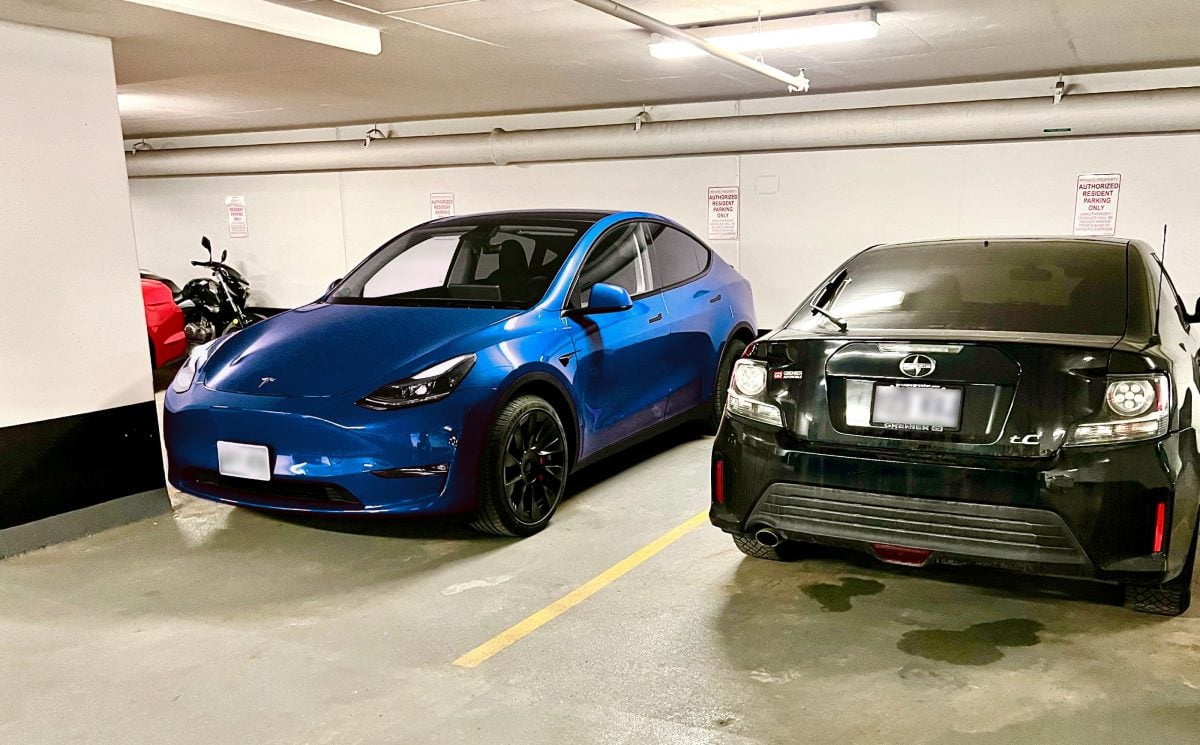One of the primary benefits of EV ownership is charging at home and starting each morning with optimal battery state of charge and driving range. But for many people, including myself, charging is not possible where I park my Tesla Model Y for the night. Is that a deal breaker for owning an EV? It doesn’t have to be. After ten months of ownership, I have made it work with only minor compromises. Public charging infrastructure is growing quickly (and accelerating) as EVs are growing in popularity.
Having that said, what are the downsides of not having any EV charging in your apartment parking garage?
- Going out of your way to charge: Instead of charging the EV while it is parked and not in use, you will need to plan a charging stop for when you go out. Sometimes this can be along your route, while other times you have to plan a detour. The Plugshare app is your best friend, because you can find lots of level 2 chargers close to your destinations, so your EV is charging while you’re out and about.
- Extra charging stops: Related to the first point, not having home charging means you will need more charging stops to cover the same distance. Why? Because the navigation system in Teslas and other EVs often plans your route with ~10% battery remaining on arrival to your destination. We know that it is unhealthy for your EV battery to be parked with a very low (or high) state of charge for extended periods of time. When I go on 200-mile day trips, I need to make an extra Supercharger stop close to my home so that I park the car with 40-50% remaining, and the car is ready for the next trip. If I had charging in my apartment building, then I would be able to skip the last charging stop and arrive home with a fully depleted battery.
- Plan for vampire drain: It is normal for EVs and their batteries to lose about 1% of battery charge per day when not in use. This is due to electronics and battery management systems operating in the background and is normal. While this won’t be an issue day to day, it is something to consider when parking your car unplugged for weeks at a time.
Note: When your Tesla has Sentry Mode enabled for security, vampire drain can be as high as 7-8% per day. You probably don’t want Sentry Mode turned on all the time.
So how can you drive an EV and live in an apartment complex with no charging infrastructure? Over the last ten months of ownership, I found the following solutions.
Places for Apartment Dwellers to Charge their EVs
Superchargers & Electrify America Level 3 Charging Stations
Most of the time I go to Tesla Supercharger locations every couple of days to charge back up to 80 or 90%. DC fast charging stations are the fastest way to add back range to the car. Although Supercharging is 3x or 4x more expensive than charging at home in the off-peak hours.
Time to charge: 15-25 minutes to charge to 80%
Public Parking Lots
Although my condominium building has absolutely no EV charging infrastructure, the office building next door has 12 Level-2 publicly accessible charging stations that are severely underutilized after business hours. Although I’d have to pay to park there in addition to $1.50 per hour to charge, it is still cheaper than filling up a gas tank. Check your area if you have any public parking lots with chargers to use in a pinch.
Time to charge: Typically adds 10-15% of battery per hour
Your Work Office or School Campus
I work from home, but many office commuters will find that many office buildings are adding level 2 charging equipment to their parking garages. Charging is often free or included with the cost of parking. Expect 32 amp Level 2 chargers.
Time to charge: Typically adds 10-15% of battery per hour
Shopping Malls
Just like other public parking lots, many malls around the country are adding charging equipment to their parking garages. Doing some shopping or watching a movie at the theater is a great opportunity to add 25-50% back to your battery on Level 2 chargers. Check the Plugshare app to see if your local shopping center has EV charging.
Time to charge: Typically adds 10-15% of battery per hour
To sum it all up; having a charging solution at home is definitely going to make living with an EV easier and more convenient. Living in an apartment building with no charging is possible, but you’d need to be willing to make some compromises an plan your trips more thoroughly in advance.
Considering buying a Tesla? Use our referral link to get $1,000 off, and help support our content.
